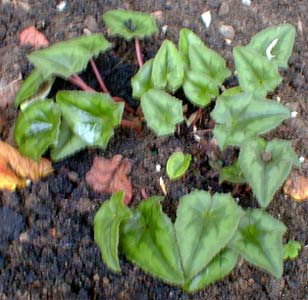
'Green Elf'
Dwarf Autumn Cyclamen
Comatas: Already, Morson, some one is waxing bitter, dust thou see
no sign of it? Go, go, & pluck, forthwith, the squills from some
old wife's grave.
Lacon: And I too, Morson, I make some one chafe, & thou dost
perceive it. Be off now to the Hales stream, & dig cyclamen.
-Life of Theocritis, from Suidas
translated by Andrew Lang
translated by Andrew Lang
At a favorite nursery, I was glancing over a group of Cyclamen hederifolium mostly of a very similar appearance, but spotted one with very tiny, strongly hastate (spear-shaped) leaves. I asked one of the workers, "Do you know what this one is? It's not the same as these other cyclamens."
He didn't know, so called someone over who knew more about them, & she said, "It's a regular hederifolium. It just hasn't finished growing to its full sized." I was dubious & presed further: "Are you sure? They look like fully mature leaves. Well, whatever it is, I want it."
What it was, as it turned out, was a rarely offered cultivar, 'Green Elf,' with leaves one-third or one-fourth the normal size, a mite thinner than is average for the species, & with its arrow-pattern somewhat faded green against lighter green. This variety was developed by Basil Smith in England. It was introduced to cyclamen devotees in 1989.
A local grower had imported plugs (wholesale seedlings) & developed a massive number of regular C. hederifoliums for the autumn market. But just a few odd things popped up among the maturing seedlings, among which I was able to grab for a fraction of their usual price a single 'Green Elf' & a silver-leafed 'White Cloud.'
'Green Elf' was installed in the garden at the base of an American witchhazel, surrounded by small Tasselled Hyacinths (Muscari comosum) which are inactive autumn & winter when the cyclamen is in its glory, & taking over the spot to show off once spring arrives & the cyclamens are vanishing.
'Green Elf' has small light pink flowers in late August or September, followed by the tiny leaves which co-exist with the flowers until early October. When the flowers are completed, the charming groundcovering leaves remain until January or March. Even more than most cyclamens it demands to be at the front of the garden, with nothing nearby that would hide its diminutive presence.
Continue to
Cyclamen hederifolium,
Curly-leaf